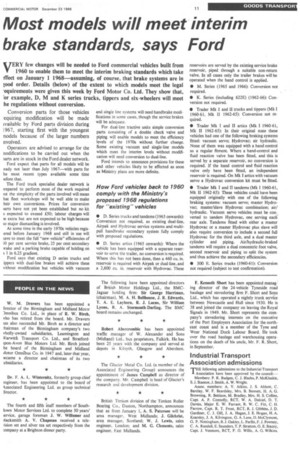Most models will meet interim brake standards, says Ford
Page 13

If you've noticed an error in this article please click here to report it so we can fix it.
VERY few changes will be needed to Ford commercial vehicles built from 1960 to enable them to meet the interim braking standards which take ffect on January 1 1968—assuming, of course, that brake systems are in good order. Details (below) of the extent to which models meet the legal .equirements were given this week by Ford Motor Co. Ltd. They show that, or example, D, M and K series trucks, tippers and six-wheelers will meet he regulations without conversion.
Conversion parts for those vehicles • equiring modification will be made ivailable by Ford parts division during 1967, starting first with the youngest nodels because of the larger numbers nvolved.
Operators are advised to arrange for the nodifications to be carried out when the >arts are in stock in the Ford dealer network.
Ford expect that parts for all models will be eady not later than July 1967—with parts for he most recent types available some time )efore that.
The Ford truck specialist dealer network is wepared to perform most of the work required nit the simplicity of the parts involved will mean hat fleet workshops will be well able to make heir own conversions. Prices for conversion mils have not yet been established but no kit s expected to exceed £50; labour charges will ie extra but are not expected to be high because to major dismantling is involved.
At some time in the early 1970s vehicles regisered before January 1968 and still in use will save to meet the full "new-vehicle" efficiencies of 50 per cent service brake, 25 per cent secondary wake and a parking brake capable of holding on I 1 in 6.25 gradient.
Ford says that existing D series trucks and ippers with dual-line brakes will achieve these vithout modification but vehicles with vacuum and single line systems will need handbrake modifications in some cases, though the service brakes will be adequate.
For dual-line tractive units simple conversion parts consisting of a double check valve and piping will enable models to meet the efficiency levels of the 1970s without further change. Some existing vacuum and single-line models which meet the interim levels without modification will need conversion to dual-line.
Ford intends to announce provisions for these and other vehicles likely to be affected as soon as Ministry plans are more definite.
How Ford vehicles back to 1960 comply with the Ministry's proposed 1968 regulations for "existing" vehicles
• D. Series trucks and tandems (1965 onwards): Conversion not required, as existing dual-line, Airpak and Hydrovac service systems and multipull handbrake secondary system fully comply with proposed regulations.
• D. Series artics (1965 onwards): Where the vehicle has been equipped with a separate reservoir to serve the trailer, no conversion is required. Where this has not been done, then a 460 cu. in. reservoir is required with Airpak or dual-line, and a 2,600 cu. in. reservoir with Hydrovac. These
reservoirs are served by the existing service brake reservoir, piped through a suitable non-return valve. In all cases only the trailer brakes will be operated when the hand control is applied.
• M. Series (1965 and 1966): Conversion not required.
• K. Series (including 622E) (1962-66): Conversion not required.
• Trader Mk 1 and II trucks and tippers (Mk I 1960-61, Mk II 1962-65): Conversion not required.
• Trader Mk I and II artics (Mk I 1960-61, Mk II 1962-65): In their original state these vehicles had one of the following braking systems fitted: vacuum servo; Hydrovac; air hydraulic. None of them was equipped with a hand control as a regular fitment. Where a hand-control and fluid reaction valve has been fitted, and this is served by a separate reservoir, no conversion is required. If the hand control and fluid reaction valve only have been fitted, an independent reservoir is required. -On Mk I artics with vacuum servo a Hydrovac conversion kit must be fitted.
• Trader Mk I and II tandems (Mk 1960-61, Mk 11 1962-65): These vehicles could have been equipped originally with one of the following braking systems: vacuum servo; master Hydrovac; master/slave Hydrovac combination; air/ hydraulic. Vacuum servo vehicles must be converted to tandem Hydrovac, one serving each rear axle. Tandems fitted with either a master Hydrovac or a master Hydrovac plus slave will also require conversion to include a second full Hydrovac for the third axle, and a dual master cylinder and piping. Air/hydraulic-braked tandems will require a dual concentric foot valve, second reservoir and piping to split the system and thus achieve the secondary efficiencies.
• 500 E. Series trucks (1960-61): Conversion not required (subject to test confirmation).












































































